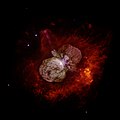Fișier:Eta Carinae.jpg

Mărimea acestei previzualizări: 600 × 599 pixeli. Alte rezoluții: 240 × 240 pixeli | 480 × 480 pixeli | 769 × 768 pixeli | 1.025 × 1.024 pixeli | 2.015 × 2.013 pixeli.
Fișier original (2.015 × 2.013 pixeli, mărime fișier: 163 KB, tip MIME: image/jpeg)
Istoricul fișierului
Apăsați pe Data și ora pentru a vedea versiunea fișierului trimisă la momentul respectiv.
| Data și ora | Miniatură | Dimensiuni | Utilizator | Comentariu | |
|---|---|---|---|---|---|
| actuală | 18 decembrie 2017 11:41 |  | 2.015x2.013 (163 KB) | The NMI User | Reverted to version as of 14:14, 1 May 2008 (UTC) |
| 13 martie 2017 16:45 |  | 3.000x2.998 (1,18 MB) | Leogorgon | larger file size | |
| 1 mai 2008 16:14 |  | 2.015x2.013 (163 KB) | Vol de nuit | {{Information |Description=(NASA News Release) A huge, billowing pair of gas and dust clouds are captured in this stunning NASA Hubble Space Telescope image of the supermassive star Eta Carinae. Using a combination of image processing techniques (ditheri |
Utilizarea fișierului
Nicio pagină nu utilizează acest fișier.
Utilizarea globală a fișierului
Următoarele alte proiecte wiki folosesc acest fișier:
- Utilizare la da.wikipedia.org
- Utilizare la en.wikipedia.org
- Star
- Eta Carinae
- Wikipedia:Selected anniversaries/March 11
- Wikipedia:Today's featured article/March 2017
- Wikipedia:WikiProject Wikipack Africa Content/Wikipedia:Showcase
- Wikipedia:WikiProject WikiFundi Content/Eta Carinae
- Wikipedia:Today's featured article/requests/Eta Carinae
- Wikipedia:Today's featured article/March 12, 2017
- Wikipedia:Main Page history/2017 March 12
- Wikipedia:WikiProject WikiFundi Content/Wikipedia:Showcase
- Wikipedia:Main Page history/2022 March 11
- Wikipedia:Main Page history/2022 March 11b
- Wikipedia:Main Page history/2023 March 11
- Wikipedia:Main Page history/2023 March 11b
- User:2003 LN6/sandbox/Eta Carinae variable
- List of luminous blue variable stars
- Utilizare la en.wikiversity.org
- User:Marshallsumter/Radiation astronomy2/Visuals
- User:Marshallsumter/Radiation astronomy2/Violets
- Stars/Astronomy
- User:Marshallsumter/Radiation astronomy2/Violets/Quiz
- Stars/Sun/Astronomy/Quiz
- User:Marshallsumter/Radiation astronomy/Courses/Principles/Hourly 2
- User:Marshallsumter/Radiation astronomy/Courses/Principles/Final quiz
- Draft:Original research/Io/Quiz
- Titan/Quiz
- Stars/Solar systems/Quiz
- Moon/Quiz
- Earth/Quiz
- User:Marshallsumter/Radiation astronomy/Colors/Quiz
- Volcanoes/Io/Quiz
- Stars/Violets
- User:Marshallsumter/Radiation astronomy2/Stars
- Stars/Violets/Quiz
- Utilizare la es.wikipedia.org
- Utilizare la fr.wikipedia.org
- Utilizare la hi.wikipedia.org
- Utilizare la it.wikibooks.org
- Utilizare la la.wikipedia.org
- Utilizare la mk.wikipedia.org
- Utilizare la ms.wikipedia.org
- Utilizare la my.wikipedia.org
- Utilizare la oc.wikipedia.org
- Utilizare la ru.wikipedia.org
- Utilizare la sk.wikipedia.org
- Utilizare la sr.wikipedia.org
- Utilizare la th.wikipedia.org
Vizualizați utilizările globale ale acestui fișier.
